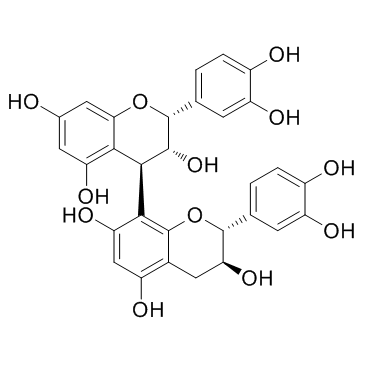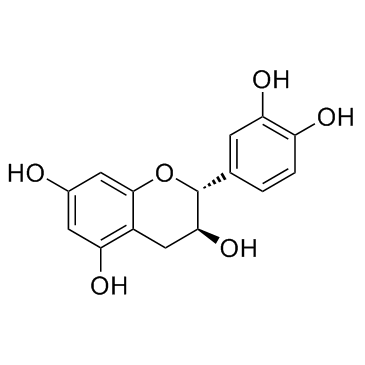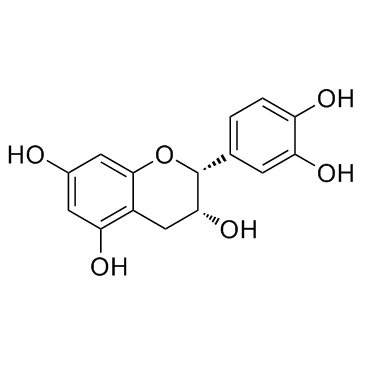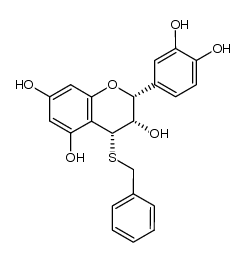20315-25-7
| Name | procyanidin b1 |
|---|---|
| Synonyms |
Proanthocyanidin B2
(2R,2'R,3R,3'R,4R)-2,2'-Bis(3,4-dihydroxyphenyl)-3,3',4,4'-tetrahydro-2H,2'H-4,8'-bichromene-3,3',5,5',7,7'-hexol Proanthocyanidin B1 4,8"-Bi-[(+)-epicatechin] PROCYANIDINDIMERB2 ProcyanidinB1 Procyanidin B1 Procyanidol B2 Procyanidin B2 Proanthocyanidin UNII-L88HKE854X (2R,2'R,3R,3'S,4R)-2,2'-Bis(3,4-dihydroxyphenyl)-3,3',4,4'-tetrahydro-2H,2'H-4,8'-bichromene-3,3',5,5',7,7'-hexol |
| Description | Procyanidin B1 is a polyphenolic flavonoid isolated from commonly eaten fruits, binds to TLR4/MD-2 complex, and has anti-inflammatory activity. |
|---|---|
| Related Catalog | |
| In Vitro | Procyanidin B1 is a polyphenolic flavonoid isolated from fruits and fruit juices, binds to TLR4/MD-2 complex, and has anti-inflammatory activity. Procyanidin B1 causes cellular toxicity at concentrations >100 μg/mL. Procyanidin B1 (100 μg/mL) inhibits LPS-induced TNF-α production, and expression of MD-2, TRAF6, NF-κB mRNA, phosphorylated p38 MAPK and NF-κB protein in THP1 cells[1]. Procyanidin B1 (50-100 µM) protects against Aβ oligomer-induced neuronal death. Procyanidin B1 potently inhibits the activation of caspase-3 at 100 µM, caspase-8 at concentrations of 30, 50, and 100 µM and caspase-9 at concentrations of 10, 30, 50, and 100 µM[2]. Procyanidin B1 (10, 20, 30 μM) significantly and dose-dependently induces expression of ACO and CPT1, with no obvious effect on mRNA expression of PPARα[3]. |
| Cell Assay | To investigate the cytotoxic effect of Procyanidin B1, viability of THP1 cells is assessed using CCK8 assay. THP1 cells are treated with Procyanidin B1 for 18 h, and 10 μL of CCK8 solution is then added to each well and the cultures are incubated for 4 h at 37°C. The optical density (OD) at 450 nm is measured using an ELx808 Absorbance Microplate Reader. The Procyanidin B1 concentration tested ranges from 50 to 200 μg/mL. Each sample is tested in triplicate[1]. |
| References |
| Density | 1.7±0.1 g/cm3 |
|---|---|
| Boiling Point | 955.3±65.0 °C at 760 mmHg |
| Melting Point | 231~232℃ |
| Molecular Formula | C30H26O12 |
| Molecular Weight | 578.520 |
| Flash Point | 531.6±34.3 °C |
| Exact Mass | 578.142456 |
| PSA | 220.76000 |
| LogP | 0.30 |
| Vapour Pressure | 0.0±0.3 mmHg at 25°C |
| Index of Refraction | 1.803 |
| Storage condition | 2-8°C |
| Personal Protective Equipment | Eyeshields;Gloves;type N95 (US);type P1 (EN143) respirator filter |
|---|---|
| Hazard Codes | Xi |
| Risk Phrases | 24/25 |
| Safety Phrases | 24/25 |
| RIDADR | NONH for all modes of transport |
| WGK Germany | 3 |
| HS Code | 29329990 |
| Precursor 6 | |
|---|---|
| DownStream 4 | |



![(2R-trans)-2-[3,4-bis(phenylmethoxy)phenyl]-3,4-dihydro-5,7-bis(phenylmethoxy)-2H-1-benzopyran-3-ol structure](https://image.chemsrc.com/caspic/113/20728-73-8.png)


![[4,8]-2,3-cis-3,4-trans:2,3-trans-octa-O-benzyl-(-)-3-O-acetyl-(-)-epicatechin-(+)-catechin structure](https://image.chemsrc.com/caspic/357/664351-42-2.png)

